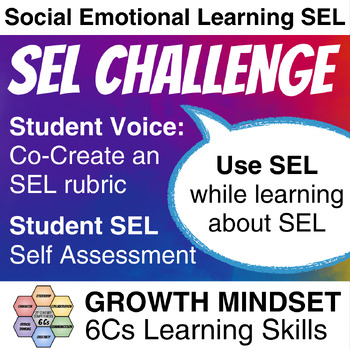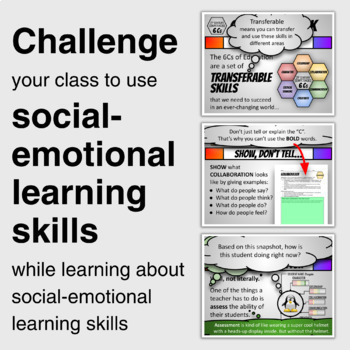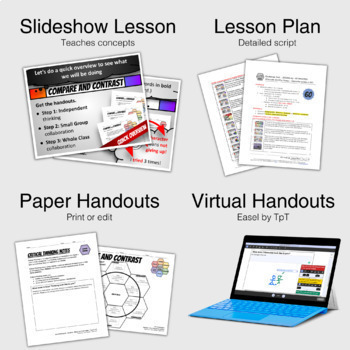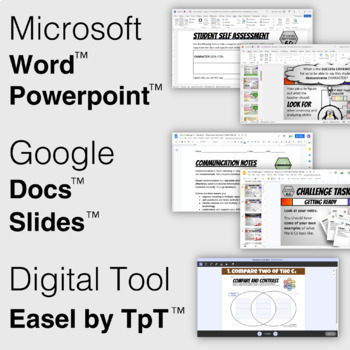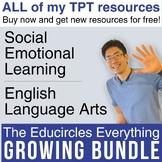Social Emotional Learning Class Challenge | Activity | SEL | Growth Mindset 6Cs
- Zip
- Easel Activity

Products in this Bundle (3)
Bonus
Also included in
- A Social Emotional Learning curriculum that isn't babyish or cheesy! Here are 90+ fun lessons to build Social Emotional Learning skills that help students succeed at school and in life! Reset classroom expectations by explicitly teaching students: character, citizenship, collaboration, communicationPrice $54.99Original Price $242.00Save $187.01
- This growing bundle includes every single resource in my TPT store. Buy now and get all future resources for free!Oh no, you missed out! This resource was on sale for $100 to celebrate 100,000 downloads across my TPT store. Make sure to join the Educircles Club Newsletter to get free stuff and speciPrice $144.00Original Price $482.49Save $338.49
Description
Switch into learning mode with this Social Emotional Learning Skills Class Challenge!
Can your students
- USE Social Emotional Learning Skills
- WHILE LEARNING ABOUT Social-Emotional Learning Skills (6Cs / growth mindset life skills)
- as they CO-CREATE a SEL Social Emotional Learning Skills rubric.
Teacher Feedback: "This has been great to use with my 6th grade advisory. Thanks!" — Rachel W. ⭐⭐⭐⭐⭐
Sometimes your class needs a reset button.
This 6Cs Social Emotional Learning Skills Challenge improves student involvement and critical thinking abilities while promoting social-emotional learning (SEL).
Check out the product preview PDF to learn more!
1. Systematic and Cumulative Learning
Students brainstorm and document ideas as they learn about each "C." Each part builds on previous concepts to help students gain a deeper understanding.
- Section A: Students learn about the 6Cs.
- Section B: Students co-create a learning skills rubric for each "C"
- Section C: Students use the 6Cs while doing a collaborative task.
2. Direct, Explicit Instruction
Students receive deliberate teaching of all concepts. The slideshow lesson explains how to fill out the worksheets.
3. Real World Literacy and Social Emotional Learning Skills
Social Emotional Learning that isn't babyish. These are transferable skills we use in the classroom, at work, and the real world.
4. Feel Confident
Feel confident explaining the 6s Growth Mindset / Social Emotional Learning Skills to your students using the detailed lesson plan as a discussion guide.
UNIT OVERVIEW:
SECTION A What are the 6Cs?
- LESSON 1: Begin with an introduction to transferable skills and the 6Cs Learning Skills. Explain to students how to demonstrate comprehension using the "Show Don't Tell" worksheet and provide an example of a strong answer. Explore the concept of CHARACTER handout including ideas around growth mindset and perseverance strategies.
- LESSON 2: Explore the concept of CITIZENSHIP. Students demonstrate comprehension using the "Show Don't Tell" worksheet. For example, What is an ideal citizen? Which communities do you belong to? Discuss empathy, equality and fairness. Would you rather solve Racism vs Sexism?
- LESSON 3: Explore the concept of COLLABORATION. Students apply the "Show Don't Tell" method to express their understanding of how collaboration and teamwork are not the same thing. The lesson involves discussions of collaboration strategies, teamwork styles (collaboration, coordination and cooperation), and students analyze examples to look for similarities and differences between these teamwork styles.
- LESSON 4: Explore the concept of COMMUNICATION. Students use the "Show Don't Tell" worksheet to express their understanding of communication, including its components and styles. The lesson covers assertive, aggressive, passive, and passive-aggressive communication styles, and emphasizes the importance of perspective in interpreting messages. Students analyze different communication breakdowns and strategies for effective communication.
- LESSON 5: Explore the concept of CREATIVITY. Students use the "Show Don't Tell" worksheet to express their understanding of creativity beyond art, applying it to everyday problem-solving and innovation. The lesson covers the notion that creativity is a learnable skill linked to a growth mindset, and encourages students to identify and apply creative strategies in various scenarios.
- LESSON 6: Explore the concept of CRITICAL THINKING. Students use the "Show Don't Tell" worksheet to demonstrate their understanding of critical thinking as applied to evaluating current issues like fake news and media biases. The lesson emphasizes analyzing information from various perspectives, recognizing unconscious biases, and understanding different viewpoints. Students engage in activities to practice being open-minded and full-minded, utilizing critical thinking strategies in discussions about media / digital literacy, news credibility, and the impact of filter bubbles when using a search engine (i.e. Google).
SECTION B Co-creating Criteria for the 6Cs (Student Input)
- LESSON 7: Introduce the concept of "Look Fors" and explain we will be co-creating a Learning Skills rubric (assessment criteria) for each of the 6Cs. The lesson involves a step-by-step process where students first engage in independent thinking to determine what constitutes CHARACTER, then collaborate in groups to build on these ideas. Through group discussions and the application of critical thinking strategies, the class collectively develops a shared understanding of CHARACTER. This process emphasizes student input and collaboration in creating assessment criteria, fostering a deeper understanding and ownership of the learning objectives.
- LESSON 8: Co-create the assessment criteria for CITIZENSHIP using the same structured process used in the previous lesson.
- LESSON 9: Co-create the assessment criteria for COLLABORATION using the same structured process used in the previous lesson.
- LESSON 10: Co-create the assessment criteria for COMMUNICATION using the same structured process used in the previous lesson.
- LESSON 11: Co-create the assessment criteria for CREATIVITY using the same structured process used in the previous lesson.
- LESSON 12: Co-create the assessment criteria for CRITICAL THINKING using the same structured process used in the previous lesson.
SECTION C Compare and Contrast the 6Cs
In this section, students practice using the 6Cs Learning Skills while they develop a deeper understanding of the 6Cs Learning Skills. Students use the same structured process (independent thinking, small group collaboration, and whole class collaboration) to compare and contrast the 6Cs.
The lesson emphasizes creativity in approach, allowing students to use various brainstorming tools like Venn diagrams or lists. There is also an opportunity for teacher assessment and student self-assessment of Learning Skills used during this activity.
- LESSON 13: Explain how students get an opportunity to use the 6Cs Learning Skills while thinking about the 6Cs Learning Skills. Students do the first step (independent thinking) to answer the guiding question: Which Cs are the most similar? Which Cs are the most different?
- LESSON 14: Students do the second step (small group collaboration) to explore the guiding question. At the end of the lesson, students do a self-assessment of their learning skills while working in small groups.
- LESSON 15: Students do the final step (whole class collaboration) to explore the guiding question. Revise the class learning skills rubric based on the new understanding of the 6Cs gained from this activity. At the end of the lesson, students can do another self-assessment of their learning skills.
- LESSON 16: Optional Summative Task. If we think of the Compare and Contrast activity (Lessons 13, 14, 15) as a formative assessment, then this lesson could be a summative evaluation to see how students have improved. Three possible guiding questions are provided, as well as teaching suggestions to conduct the summative task as 1) a collaborative project summative or 2) a more traditional paper-and-pencil test.
Want to see exactly what you get before you buy this bundle?
- Look at the BUNDLE PREVIEW PDF. (Click the “view preview” button underneath the product cover section at the top of this page.)
- It is a low-resolution version of the entire PDF resource.
This bundle includes the following resources
- Section A. What are the 6Cs Learning Skills?
- Section B. Co-creating criteria for Learning Skills
- Section C. Compare and Contrast Learning Skills
- Note: you need all 3 sections as they build on each other.
IMPORTANT: Answer Key not provided
- Student answers will vary based on class discussions.
- The point of the Challenge Task is to have classes collaborate and generate new ideas based on their evolving understanding of 21st Century Skills / Competencies / Learning Skills
- If you get stuck, email me: Mike@educircles.org
Handouts explain the 6 Cs Learning Skills.
(The 6Cs are six of the seven transferable skills in the new Ontario Language 2023 Curriculum.)
- Character
(i.e., self-directed learning in the Ontario Language 2023 Curriculum)
- Citizenship
(i.e., global citizenship and sustainability in the Ontario Language 2023 Curriculum)
- Collaboration
(Collaboration in the Ontario Language 2023 Curriculum)
- Communication
(Communication in the Ontario Language 2023 Curriculum)
- Creativity / Innovation
(i.e., Innovation, creativity and entrepreneurship in the Ontario Language 2023 Curriculum)
- Critical Thinking
(i.e., Critical Thinking and problem solving in the Ontario Language 2023 Curriculum)
❤️ Need to address some classroom issues?
Do you find students have spent too much online and have forgotten how to learn in class?
- The best time to use this resource to train your students was at the start of the school year.
- The second best time is right now.
- If we want students to improve, we need to train them. This 6Cs resource can help.
Real World Social-Emotional Learning that isn't babyish!
- In my grade 8 class, we explored the 6Cs and social-emotional learning skills.
- These skills didn't just help my students - they helped me rewrite my life story. They turned the hardest time of my life into something positive.
- I've used my professional experience as a teacher and my own lived experience with tough times to create these lessons.
Perfectly aligned to the Common Core!
- The CCSS standards are listed at the top of this TPT product page!
Perfect for teaching Transferable Skills in the new Ontario Language 2023 Curriculum!
- Ontario Language 2023 Curriculum A1. Transferable Skills
- Ontario Language 2023 Curriculum A2. Digital Media Literacy
- Ontario Language 2023 Curriculum A3. Application, Connections and Contributions
- Ontario Language 2023 Curriculum B1. Oral and Non-Verbal Communication
- Ontario Language 2023 Curriculum C3. Critical Thinking in Literacy
- Ontario Language 2023 Curriculum D1. Developing Ideas and Organizing Content
- Ontario Language 2023 Curriculum D2. Creating Texts (learning skills rubric)
- Ontario Language 2023 Curriculum D3. Publishing, Presenting and Reflecting (reflecting on learning skills rubric)
⭐ Use this life-long tool over and over again!
- Train your students during New Years 2024 Activities at the start of the year, semester or term to set the tone for a year of learning!
- Have students work in groups and co-create learning expectations.
- This group challenge can be used at any time to reboot your classroom community.
- Leave detailed lesson plans for a substitute teacher to use.
- Have fun in June during END OF YEAR activities while learning important transferrable skills.
⭐ The best time to plant a tree was 25 years ago. The second best time is now.
It doesn't matter what you teach:
- homeroom / advisory
- life skills
- guidance or careers
- critical and creative thinking
- English Language Arts
- Any subject-based specialty class
- Social-Emotional Learning
Encourage Social-Emotional Learning and a GROWTH MINDSET by exploring transferable skills that students can apply
- in class,
- at home,
- in relationships, and
- in an ever-changing world.
⭐⭐⭐⭐⭐ TEACHER FEEDBACK ⭐⭐⭐⭐⭐
- "This has been great to use with my 6th grade advisory. Thanks!" (⭐⭐⭐⭐⭐ Extremely satisfied - Rachel W, February 11, 2021)
..... Friday, April 18, 2024 UPDATE: It's the weekend! Woo hoo!
- Need something quick and easy?
- ASK YOUR STUDENTS: Who is texting and what is going on?
- Then ask them if Christine is an astronaut or teacher...
Wait. It's almost May. Where does the time go? You need marks.
Are your students starting to check out? Can you relate to any of these classroom problems?
Problem #1: Students don't try, especially when things don't work right away. They give up.
- ➡️ Check out this CHARACTER unit
Problem #2: Students don't do the right thing or stand up for each other. Being part of a classroom means being an active citizen. We don't always agree, but it's important to speak up.
- ➡️ Check out this CITIZENSHIP unit
Problem #3: Students don't know how to work in groups. Collaboration is not the same as teamwork. One person doing all of the work is not collaboration.
- ➡️ Check out this COLLABORATION unit
Problem #4: Students are mean, especially when they're upset. Good communication isn't just about presentations. It's also about getting your point across when both sides are upset, and things matter!
- ➡️ Check out this COMMUNICATION unit
Problem #5: Students wait for someone else to solve their problems. Creativity is about connecting ideas in new ways. When you are faced with a tricky problem, we use creativity to create a solution. Creativity is a skill we can learn.
- ➡️ Check out this CREATIVITY unit
Problem #6: Students believe rumors, gossip, and viral posts. They don't think for themselves.
- ➡️ Check out this CRITICAL THINKING unit
Problem #7: ALL OF THE ABOVE
- ➡️ Check out this CHALLENGE TASK. Can your class learn about a growth mindset while trying to stay in a growth mindset at the same time?
My name is Mike Fuchigami. I'm the Grade 8 teacher behind Educircles.
- I taught middle school English Language Arts for 13+ years in Ottawa, Ontario.
- I had a mental health crisis because of something that happened at school.
- Social Emotional Learning skills (6Cs) literally saved my life. That's why I'm so passionate about this stuff.
- I want to help your students develop Growth Mindset and Social Emotional Learning skills.
- ➡️ Read the article: Former Teacher Michael Fuchigami puts spotlight on lack of student mental health protection
Teachers around the world have DOWNLOADED 111,121 Educircles resources in over 59 countries!
- I donate 10% of everything I earn to STUDENT MENTAL HEALTH organizations. It's a promise I made to get through some dark times.
- Together, we've donated $15,520.51 (Check out the donation log.)
✅ SAVE HOURS OF PREP (and money) with a bundle!
⭐ This is the TED talk that I will give one day. If you like this, then you will love my resources.
Read more about How to teach 21st Century Skills to students on the Educircles website.
SINGLE PDF update - v2022-08-03
This product has been simplified into a Single PDF to print.
- The PDF has all of the handouts, and a "FILE Table of Contents" with one-click links to get individual files.
- Files are now packaged by section A. What are the 6 Cs B. Co-creating criteria for learning skills C. Compare and contrast learning skills
- instead of splitting Google Drive folders by use Folder 1 Print and Teach Folder 2 Edit the documents Folder 3 Google Classroom Folder 4 Google Classroom
I added a digital learning version (Easel by TpT)
I added Microsoft versions for all files
For a complete list of changes, please see the changelog at the end of the Single PDF.
FREE RESOURCE ALERT!
FREE one hour ChatGPT Critical Thinking video lesson
Ready or not, ChatGPT and Artificial Intelligence will completely change the world.
- How do we prepare our students to survive and thrive in a world with ChatGPT?
- ChatGPT is simultaneously the world’s best learning tool and cheating tool.
- (The internet is funny that way. It is an incredible productivity and procrastination tool all at the same time!)
- Imagine your kids and students grew up today without ever using the internet.
- How would they survive and thrive in a world where so much of life relies on the internet?
- Are they at a competitive disadvantage if they don’t keep up with changes in media literacy and digital literacy?
- Save time and money: Get the ChatGPT growing bundle.
Questions? Email Mike@educircles.org or ask in the Question and Answer section

